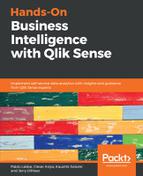Now, let's show exactly where the collisions happened. We could use a bubble layer to show the points, but as we saw in the Concepts of GeoAnalytics section, when you have too many points, it is usually advisable to use a heatmap since this map does not hide overlapping points (two or more close points are shown in a warmer color, so you know where more collisions happened).
To add a heatmap layer, follow these steps:
- Drag and drop a custom object of type Heatmap Layer, as demonstrated in the following screenshot:

- Choose the dimension for our layer and choose our field, collision_point, as shown in the following screenshot:

Now, we are going to see a map like the following screenshot:
There are some issues with this, however. Let's look at them before we begin tackling these issues:
- We did not set which measures were meant to be evaluated, so GeoAnalytics will calculate the gradient over the points plot and we are interested in how many collisions took place (the same crossing could have more than one collision).
- The heatmap layer is being shown for all selections. Since we require more precise information, we're going to show this layer when there's only one ZIP code selected.
- Due to performance limitations, only 1.000 points were evaluated.
Let's work on each of these points now, as follows:
- Go to the Location | Weight section of the heatmap layer. GeoAnalytics expects that the first parameter should be the location (geometry), and the second should be the measure being evaluated. This order is important; configure both measures (clicking Add measure first) as the following screenshot depicts. This will fix the first issue, so that now the measure being evaluated shows how many collisions happened and not how many points have had collisions:

- Configure the layer to show only when there's one ZIP code selected, and let the layer show more than 1.000 points. Go to the Layer Options section, change the value of Maximum Number of Objects to 100000 points, and set Calculation Condition to count(DISTINCT zip_code) = 1. Uncheck the Include in Auto Zoom option because the Auto Zoom feature will be evaluated only for ZIP areas borders (this is faster to calculate than for each point), as shown in the following screenshot:

- To test our map again, clear all of the selections, and check if the maps are plotted as before. Then, select MANHATTAN as we did previously. The behavior of the maps (before the selection) should be equal to the last version of the map without the heatmap. It should appear only after a selection into the zip_code field (remember our Calculation Condition parameter). You may notice that an exclamation mark appears over the layer, indicating that it isn't being calculated:

- Select (click in a zip_code area, for example 10,035). Here, you're now going to see that our heatmap appears to show how many collisions happened in every region. You can scroll using your mouse or pitch your tablet, so that you can zoom in your map showing the collisions over the street crossings. Remember that the heatmap layer does not have a bubble layer with additional information:

In the next section, we will see how to add more information to our map.
